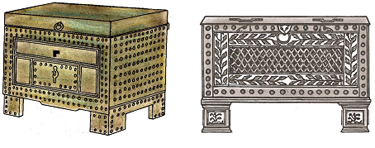In the homes
Cicero, the most famous of the Roman orators, wrote, “Is there anything more sacred, anything more surrounded by all kinds of inviolability than the individual citizen’s home?”
Thanks to archeological digs in the cities of Pompeii and Herculaneum, buried and preserved in volcanic ash, we know how people lived and what everyday life was like in a Roman city at the end of the first century AD. In both cities, people lived in houses and apartments that were sparingly, simply furnished. The residents used primarily large cupboards and wooden chests for storage. The design and adornment of the furniture was determined by the prevailing Greek style and current fashion.
Many homes had wooden chests with flat lids, painted and carved, with or without locks. They varied in size and were neatly placed on the floors along the walls. Chests also served as the families’ closets, storing clothing and household utensils, and pretty little boxes held women’s jewelry. Locks ensured their security. The archeological digs found that, despite the disaster, many of the chests had still preserved their contents.
Thus the Romans brought advanced technological thinking into everyday life. In Pompeii there was an example of a locking cash chest reinforced with iron and bronze fittings. There were also stationary cash chests securely anchored onto a stone base.
 |
| Roman cash chests. Sketched and partially reconstructed by the author |
In all ages, people have stolen out of hunger, envy, desire or curiosity. The citizens and slaves of Ancient Rome were no exception. Many stole because they had not yet learned the difference between right and wrong, or simply because their own society lacked clear laws and rules.